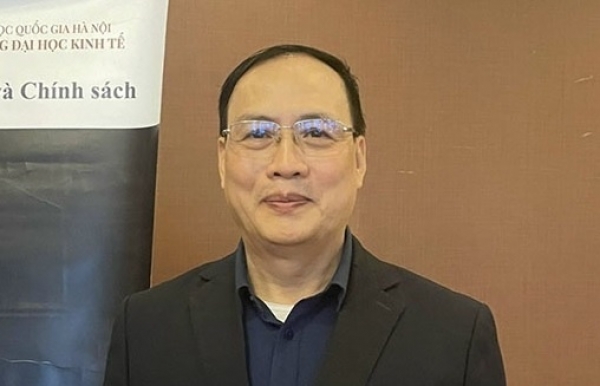Vietnam aims to make its mark on the semiconductor industry – Vietnam Investment Review
Can you tell us about Vietnam’s position and prospects in the high-tech field of semiconductors?
Vietnam is asserting its presence in the global semiconductor industry by leveraging strategic partnerships and geographic advantages. The recent upgrade to a Comprehensive Strategic Partnership with both the US and Japan has been a catalyst. US President Joe Biden’s affirmation of enhanced collaboration with Vietnam in areas such as cloud computing, semiconductors, STEM, innovation, and AI underscores the strategic importance of Vietnam to the US, especially as a crucial supplier of rare earth minerals vital for the high-tech sector, including semiconductor manufacturing.
Is the current shortage of skilled semiconductor engineers here an obstacle to growth?
The semiconductor industry here, with its exports to the US valued at over $500 million annually, primarily focuses on assembly, packaging, and testing.
The Comprehensive Strategic Partnership has set a new cornerstone for integrating science, technology, and innovation into the bilateral relationship’s core. This strategic pivot necessitates a concerted effort to allocate resources and intellectual capital towards Vietnam’s priority sectors, notably semiconductors. Enhancing cooperation with academic institutions for talent development and engaging top researchers for university-level semiconductor education are pivotal steps towards deepening Vietnam’s involvement in the global supply chain beyond assembly and testing to include chip design.
Resolution 103/2023/QH15 spotlights the imperative to rejuvenate and escalate industries, with a keen focus on the semiconductor manufacturing sphere. This approach is poised to catalyse economic growth, underscoring the nation’s commitment to becoming a formidable player in the global high-tech arena. Concurrently, the legislative framework mandates a substantial investment in human capital, targeting the cultivation of 50,000 to 100,000 highly skilled professionals within the burgeoning semiconductor research and production field by the years 2025 and 2030, respectively.
Vietnam’s electronics sector possesses the necessary infrastructure and capacity to advance its semiconductor industry ambitions. As the world’s ninth-largest exporter of electronic goods, the country boasts a rapidly developing semiconductor ecosystem, with significant potential to elevate its standing in the global supply chain. Vietnamese tech giants such as Viettel and FPT are forging paths into the global Integrated Circuit supply chain.
How realistic is this target of training between 50,000 to 100,000 engineers by 2030?
The country hosts over 300 higher education institutions, with approximately 35 offering courses in semiconductor and microelectronics engineering, reflecting a strategic shift towards addressing the burgeoning global demand for semiconductor professionals. Of these, 11 universities provide traditional programmes directly aligned with the needs of the semiconductor and microelectronics sectors.
The global semiconductor workforce is estimated at over two million, with an anticipated need for an additional million by 2030. In response, Vietnamese universities have embarked on ambitious plans to develop new course and expand enrolment in semiconductor and microelectronics design fields, aiming to bolster the country’s talent pool in this high-tech industry.
However, the quality of engineering graduates remains a concern, with only top-tier institutions like Hanoi University of Science and Technology, Ho Chi Minh City University of Technology, University of Engineering and Technology, and University of Science (part of Vietnam National University, Hanoi) currently equipped to produce engineers who meet the stringent requirements. These institutions boast robust training programmes, distinguished faculties, and access to cutting-edge technology, ensuring the selection of the brightest students to meet the high standards of the sector. The quality assurance for the remaining institutions has yet to be verified.
The journey from chip design to market-ready packaging involves a complex process lasting 4–6 months, encompassing over 500 steps and traversing more than 55,000 kilometres across approximately 70 countries. This highlights the critical need for a vast, highly skilled engineering ecosystem to succeed in the intricate world of microchip design.
What are the central challenges to achieving Vietnam’s semiconductor ambitions?
The allure of the high-tech and semiconductor sectors has prompted numerous universities to expand their offerings, often stretching beyond their current capacities. Strategic allocation of state resources, focusing on a select number of institutions that meet the training standards of developed economies, is essential for producing high-quality engineers. Therefore, government policies must support students pursuing semiconductor studies, akin to incentives provided to education majors, especially targeting top-performing and underprivileged students.
Business investment and collaboration with academic institutions are also crucial for nurturing Vietnam’s semiconductor talent pool. Attracting domestic and international researchers to teach and mobilise the Vietnamese diaspora can enrich the educational ecosystem. Promoting semiconductor applications in domestic high-tech sectors will also stimulate research and elevate training quality.
Achieving this will not only fulfill Vietnam’s high-income and development goals by 2045, but also ensure the nation’s pivotal role in the global high-tech industry, supported by strategic international partnerships and a focused talent cultivation strategy.
Under Secretary of State for Economic Growth, Energy, and the Environment Jose Fernandez shared the direction of cooperation with Vietnam in the fields of semiconductor chips, clean energy and carbon reduction at a meeting with members of the American Chamber of Commerce in Ho Chi Minh City on January 24.
By Manh Bon
What the stars mean:
★ Poor ★ ★ Promising ★★★ Good ★★★★ Very good ★★★★★ Exceptional
Vietnam Investment Review under the Ministry of Planning and Investment
Editor-in-Chief: Le Trong Minh
Deputy Editors-in-Chief: Bui Duc Hai, Nguyen Van Hong and Nguyen Quoc Viet
Editorial Board Member: Dang Tuan Khanh
Managing Editor: Nguyen Chi Mai
Advertisement | Contact us
